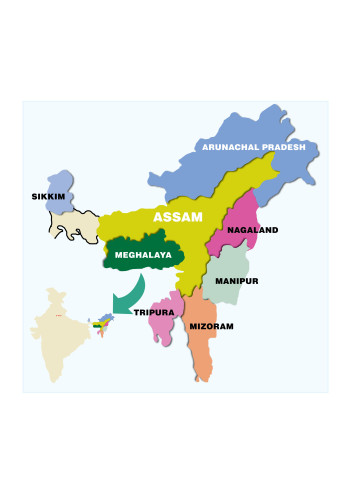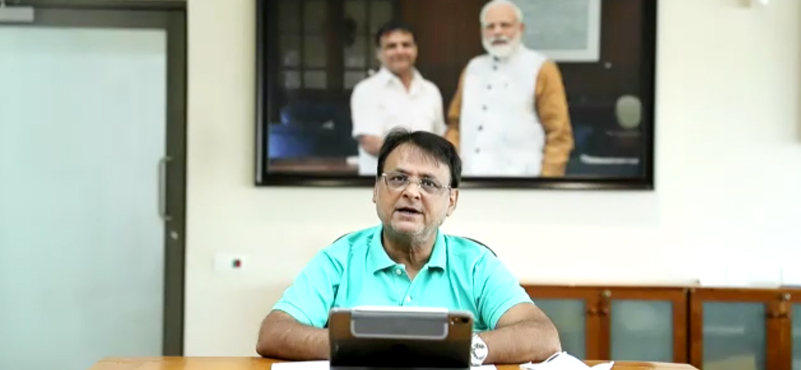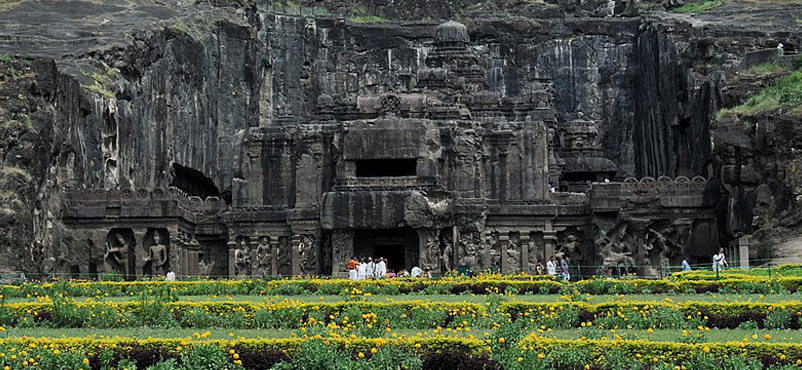India’s connectivity with the East Asian countries can be a win-win proposition for the region as whole, creating more employment and increasing tourist footfall. With a more profound outlook towards the East Asian countries, driven by ‘Act East’ policy – India could well create more prosperous Northeast and a more stable region as a whole in the years to come.
 The buzzword is “ACT EAST”, doing away with the old and creating new policies in-sync with the latest geo-political and sub-regional realities has been a hallmark of the Modi government. Understanding the importance of the Southeast and East Asian countries in India’s quest for a more meaningful role in the global order has made this buzzword an apt policy initiative.
The buzzword is “ACT EAST”, doing away with the old and creating new policies in-sync with the latest geo-political and sub-regional realities has been a hallmark of the Modi government. Understanding the importance of the Southeast and East Asian countries in India’s quest for a more meaningful role in the global order has made this buzzword an apt policy initiative.
But, we must understand the importance of tourism that lies unexplored in bringing tremendous gains in, not only, strengthening bi-lateral and regional co-operation between nations and groups, but also improving much neglected and extremely important region of Northeast.
Tourism can create a more prosperous Northeast and a more secured neighbourhood
The last budget brought some cheer for the people of Northeast as the government not only allocated a record sum of over `50,000 crores, but also deputed one of the more able Ministers as the in-charge of the MDONER (Ministry for development of the Northeast region). However, much remains desired on the ground. The need for bolstering tourism related initiative lies in the fact that it remains one of the fastest growing sectors and continued to show signs of growth despite a global economic slowdown in the past. It is also an important source of job creation providing 6-7 per cent of the world’s total jobs directly and millions more indirectly through its multiplier effect as per the UN’s World Tourism Organization. As per the Ministry of Tourism’s data on foreign exchange earnings, India amassed a hefty `107671 crores in 2013 from tourism and related activities – which has been crucial in not only maintaining a healthy foreign exchange reserve but for paying our ever mounting import bills.
In the immediate neighbourhood, Myanmar’s ascent has been equally encouraging. Myanmar, after partially opening up to the western world, post the historic elections in 2012, has seen a tremendous jump in the numbers of inbound international tourists. The numbers speak for themselves – according to the World Bank data 792,000 tourists visited Myanmar in the year 2010, which rose to a substantial two million plus in 2013. It has helped not only to bolster the sagging economy of the country crippled by numerous sanctions imposed by the western countries, but also increased people to people contact in a land marred by an authoritarian Junta.
Tourism in India, too, has improved leaps and bounds in the past decade. The country has captured a fair amount of international tourist inflow with the help of a much published and applauded “Incredible India” campaign, much better infrastructure and air-connectivity and, generally, a more adaptive and vibrant hospitality industry. However that growth has not been pan- Indian in character. Pockets of tourism centers have flourished in distinct corners of the country – some driven by MICE tourism, some by leisure and the remaining few by the virtue of showcasing India’s past heritage. But, despite having all the ingredients for making a successful and perhaps one of the leading region for tourism, Northeast has failed to realize its potential.
The northeast region shares more than 4,500 kilometres of international border , much of it – about 90 per cent of its entire border area with China in the north, Myanmar in the east, Bangladesh in the southwest, and Bhutan to the northwest. It has a rich and a vibrant culture, awe-inspiring sceneries, beautiful jungles and art and craft that can rival the best in the world – yet its commercial branding remains neglected to say the least. With a number of national parks and a rich Buddhist culture and numerous monasteries it can, indeed, showcase brand India on a global level.
What has failed us?
Connectivity and hotels remain an uncompromising aspect of developing tourist footfall in any region. Connectivity to the Northeast remains shoddy and perilous, owing, partly, to the terrain and partly because of the continuous neglect that the respective governments have bestowed on the region. Political instability, regional and ethnic conflicts and armed insurgencies have driven away any serious prospect of private funding. Sikkim is yet to have an airport and if you are looking for an escapade to the ‘organic’ state, you have to plan a trip via Bagdogra. Arunachal Pradesh seems to be a distant land with no air-connectivity, the closest one can get is to de-board at Guwahati and find a by-road means, torturing oneself on the serpentine roads that take a toll on the most avid travelers. Tripura, Mizoram and Nagaland have an airport each, while Assam is the one state in the northeast region to boast of an international airport. Rail-connectivity is in the pipe-line and will take, at least, another decade to fructify. Although the present government has laid ample stress on improving infrastructure, it will take a considerable amount of time to bring it at par with the rest of the country to attract a noticeable number of tourists.
Act East policy can bridge the gap, ‘Road to Mandalay’ can transform the region
PM Modi had stressed on the need for regional connectivity on a priority basis in his recent visit to the ASEAN Summit in Nay Pyi Taw, capital of Myanmar, in the last November. In a bid to strengthen connectivity, the PM had shown his keen desire for early completion of the ‘Road to Mandalay’ project. This, proposed, 3200 kilometer, India-Myanmar-Thailand trilateral highway, part of which entails linking India to Myanmar and then further to Southeast Asia has the potential to act as a game changer of the entire Northeast region. The project will drastically enhance connectivity between the Mekong sub-region and India. The highway project, which is to planned from Moreh in Manipur to Mae Sot in Thailand via Mandalay in Myanmar, will throw open India’s eastern border to a new bus route from Imphal to Mandalay – which would enable travelers to board a bus from Manipur’s capital to reach Mandalay in just over 14 hours!
Another project of extreme importance and an apt demonstration of the fruits of regional connectivity is the Kaladan project. When implemented, this project will connect Kolkata to Sittwe port in Myanmar, and further to Mizoram by river and road routes – opening immense possibility in not only enhancing trade but strengthening tourist footfall in the entire region. Both, India and Myanmar had signed a framework agreement in 2008 for its implementation. The construction of an extremely important section of a ‘port-cum-inland waterway’, Sittwe port, with India is steering towards completion and is likely to be wrapped up any time now.
These projects will help tap a vast number of Buddhist tourists from countries like Thailand, apart from international travel enthusiasts, seeking to explore the northeast region. Beyond these area, healthcare and IT remain other important sectors for collaboration amongst the eastern Asian countries. India is attracting a vast number of medical tourists globally, who dot Indian shores in search of reliable, affordable yet world-class healthcare. Going by a report published by the industry lobby PHD Chamber of Commerce and Industry, Indian medical tourism industry is expected to reach $6 billion in the next three years – with the number of people arriving in the country for medical treatment set to double over the next four years. A large number of patients come from the Middle East, Western Central and Eastern Africa , the SAARC nations, Central Asia and the far Pacific. India can further its outreach by tapping a number of East Asian countries to enhance its people to people contact, promote soft diplomacy and consequently increase its revenue generation.
Enhanced Bangladesh-India tourism can help the NE states
As per the ministry of tourism data for foreign tourist arrivals for the year 2013, Bangladesh has third largest number of incoming tourists to India, with over half a million tourists, forming over seven percent of the total FTA – after United States and United kingdom. Driven by trade, tourism and educational needs these tourists bring us valuable foreign exchange and business for our hospitality industry. India and Bangladesh are bound by a shared past and common heritage apart from being members of SAARC and BIMSTEC (Bay of Bengal Initiative for Multi-Sectoral Technical and Economic Co-operation). Tourism is identified as one of the fourteen important sectors of cooperation. It also shares boundaries with five Indian states naming Assam, Tripura, Mizoram, Meghalaya, and West Bengal. This association can be further intensified through more profound land connectivity and better law enforcement measures. Recently passed land boundary agreement is a step in the right direction.
Liberal Visa Regime with the East Asian countries could act as a multiplier
India, in the recent months, has taken major steps to liberalize its visa regime, making it easier to obtain e-visa through nine designated centers in India. The step was seen as a necessity to enhance global connectivity with India and create more bridges for better trade and tourism relations with the world at large. In its immediate neighbourhood, India already provides visa free entry for the citizens of Nepal, Bhutan and Maldives. However, because of security concerns this facility has been extended further in the immediate neighbourhood. The government could look at mechanisms like Visa-on-Arrival (VOA) to further liberalize people to people movement with countries like Thailand and Myanmar to create seamless connectivity – which, in turn, could fuel the growth prospects of the Northeast region as well.
How can tourism help India project its regional leadership
It remains no secret that much of the potential of the Northeastern region remains untapped and it has much to do with India’s laxity in creating better regional connectivity with the countries in the eastern Asian region. With little connectivity through land, with the rest of India, and restricted air-connectivity coupled with low levels of economic development have also been contributing factors for the instability and regional strife that comes to fore at periodic intervals in the northeastern region. Job creation and absorption of the youth in various sectors remain a major challenge to mainstream its population and create enabling environment in the region as a whole. Another important dimension of people to people contact is furthered by tourism initiatives that, in turn, will help better understanding of northeastern culture. India has been hampered by unbalanced growth – where the western part of the nation has flourished as business capital and trade hubs, while much of the eastern India has been reeling to realize its innate potential. With better regional connectivity, hopefully, this disparity will, too, be addressed.
 The new government has been keen on developing friendly relations with the immediate neighbourhood, evident by the fact that the PM chose Bhutan as his first foreign outing, following it with a trip to Nepal with much fan-fare. All these Asian neighbours of India are countries in dire need of new avenues of employment generation and infrastructural growth. Such a regional tie-up cemented by tourism can be a win-win situation for both India and its neighbours. These tie-ups can also act as strategic alliance and push India’s soft power in this region.
The new government has been keen on developing friendly relations with the immediate neighbourhood, evident by the fact that the PM chose Bhutan as his first foreign outing, following it with a trip to Nepal with much fan-fare. All these Asian neighbours of India are countries in dire need of new avenues of employment generation and infrastructural growth. Such a regional tie-up cemented by tourism can be a win-win situation for both India and its neighbours. These tie-ups can also act as strategic alliance and push India’s soft power in this region.
The diversity and uniqueness of the region have plenty to offer not only to the regional but global travelers. Given its unique and unparalleled location and varied tourism offering it can act as a global tourism hub and India could well emerge as the leader of a very noble cause. However, driven by the existing political reality in the region and lack of clarity on the part of the policy makers – not much has been achieved. The moot question remains whether India can take a lead in this process and, by enhancing its regional connectivity in the neighbourhood, create a region of prosperity. Only time will tell.
By Shashank Shekhar




































